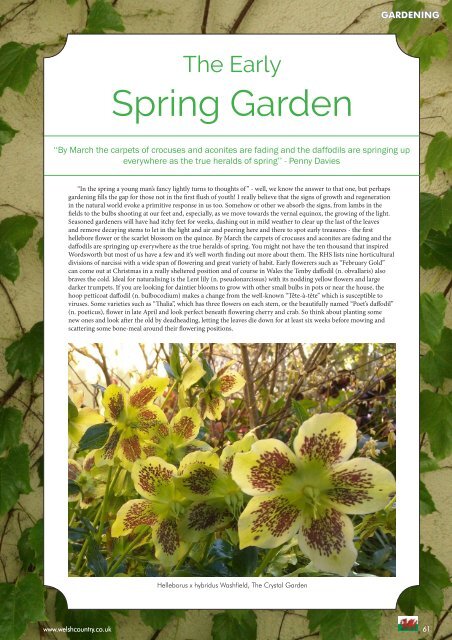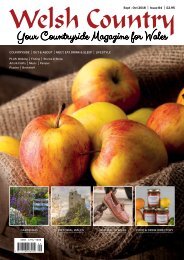Welsh Country March-April 2017
You also want an ePaper? Increase the reach of your titles
YUMPU automatically turns print PDFs into web optimized ePapers that Google loves.
GARDENING<br />
The Early<br />
Spring Garden<br />
‘‘By <strong>March</strong> the carpets of crocuses and aconites are fading and the daffodils are springing up<br />
everywhere as the true heralds of spring’’ - Penny Davies<br />
“In the spring a young man’s fancy lightly turns to thoughts of ” - well, we know the answer to that one, but perhaps<br />
gardening fills the gap for those not in the first flush of youth! I really believe that the signs of growth and regeneration<br />
in the natural world evoke a primitive response in us too. Somehow or other we absorb the signs, from lambs in the<br />
fields to the bulbs shooting at our feet and, especially, as we move towards the vernal equinox, the growing of the light.<br />
Seasoned gardeners will have had itchy feet for weeks, dashing out in mild weather to clear up the last of the leaves<br />
and remove decaying stems to let in the light and air and peering here and there to spot early treasures - the first<br />
hellebore flower or the scarlet blossom on the quince. By <strong>March</strong> the carpets of crocuses and aconites are fading and the<br />
daffodils are springing up everywhere as the true heralds of spring. You might not have the ten thousand that inspired<br />
Wordsworth but most of us have a few and it’s well worth finding out more about them. The RHS lists nine horticultural<br />
divisions of narcissi with a wide span of flowering and great variety of habit. Early flowerers such as “February Gold”<br />
can come out at Christmas in a really sheltered position and of course in Wales the Tenby daffodil (n. obvallaris) also<br />
braves the cold. Ideal for naturalising is the Lent lily (n. pseudonarcissus) with its nodding yellow flowers and large<br />
darker trumpets. If you are looking for daintier blooms to grow with other small bulbs in pots or near the house, the<br />
hoop petticoat daffodil (n. bulbocodium) makes a change from the well-known “Tête-à-tête” which is susceptible to<br />
viruses. Some varieties such as “Thalia”, which has three flowers on each stem, or the beautifully named “Poet’s daffodil”<br />
(n. poeticus), flower in late <strong>April</strong> and look perfect beneath flowering cherry and crab. So think about planting some<br />
new ones and look after the old by deadheading, letting the leaves die down for at least six weeks before mowing and<br />
scattering some bone-meal around their flowering positions.<br />
Helleborus x hybridus Washfield, The Crystal Garden<br />
www.welshcountry.co.uk 61




